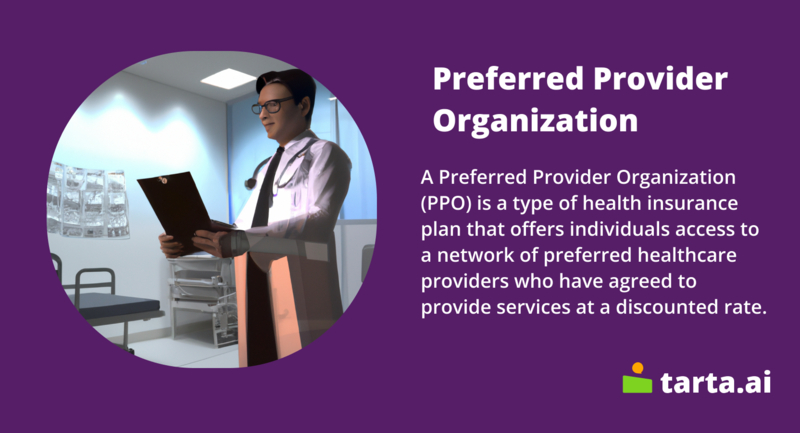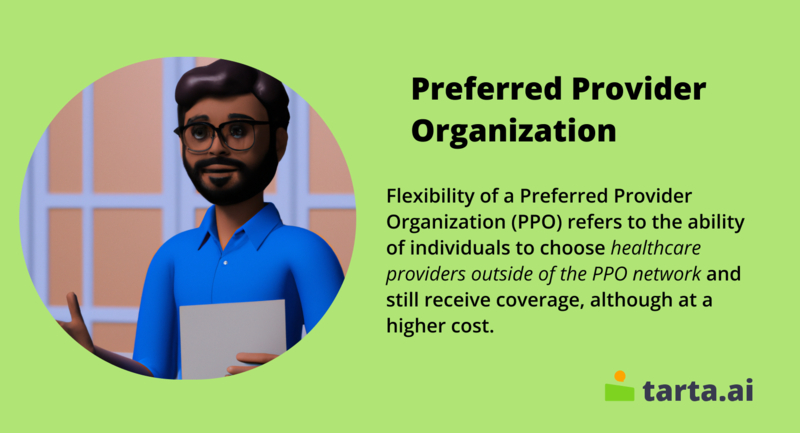Insight Into Understanding a Preffered Provider Organization (PPO)

PPO plans offer greater flexibility compared to Health Maintenance Organizations (HMOs) and Exclusive Provider Organizations (EPOs) as individuals can choose to see providers outside the network, although at a higher cost.
PPO plans typically have higher premiums compared to other types of health insurance plans, but may offer lower out-of-pocket costs for in-network services. PPO networks are usually extensive, and individuals have the option to see specialists without a referral from their primary care physician.
In a PPO plan, individuals are usually required to pay a deductible before their insurance coverage kicks in, and co-pays for in-network services may also apply. PPO plans offer several benefits, such as access to a wide network of providers and the flexibility to choose providers outside of the network. However, individuals should carefully consider their healthcare needs and budget when choosing a PPO plan, as higher premiums and potential out-of-network costs may apply.
Overall, PPO plans are a popular choice for individuals who value flexibility in choosing their healthcare providers and who are willing to pay higher premiums for that flexibility.
Network of Providers
In the context of a Preferred Provider Organization (PPO), a network of providers refers to a group of healthcare providers, such as doctors, hospitals, and other healthcare facilities, that have agreed to provide medical services to members of the PPO plan at a discounted rate.
The PPO network is usually extensive and includes a range of healthcare providers, including primary care physicians, specialists, and hospitals. Individuals who enroll in a PPO plan can typically choose to receive medical care from any provider within the network without needing a referral from a primary care physician.
However, if an individual chooses to receive medical care from a provider outside of the PPO network, they may be subject to higher out-of-pocket costs, such as higher deductibles, coinsurance, or co-payments. The PPO plan may also not cover certain services provided by out-of-network providers.
In summary, the network of providers in a PPO plan is a group of healthcare providers that have agreed to provide services to members of the plan at a discounted rate. The PPO network is usually extensive and provides individuals with a range of healthcare providers to choose from. However, individuals should carefully consider their healthcare needs and budget when choosing a PPO plan, as out-of-network costs can be higher.
Flexibility

In contrast to other types of health insurance plans, such as Health Maintenance Organizations (HMOs), PPO plans offer more flexibility in terms of choosing healthcare providers. Individuals can choose to see any provider within the PPO network without needing a referral from a primary care physician.
This flexibility can be especially helpful for individuals who live in rural areas or who have specific healthcare needs that require specialized providers. PPO plans may also provide coverage for out-of-network emergency services, allowing individuals to receive medical care from any provider in the case of an emergency.
In summary, the flexibility of a PPO plan refers to the ability of individuals to choose healthcare providers outside of the PPO network and still receive coverage, although at a higher cost. This flexibility can be beneficial for individuals who require specialized medical care or who live in areas with limited access to in-network providers. However, individuals should carefully consider their healthcare needs and budget when choosing a PPO plan, as higher out-of-pocket costs may apply for out-of-network services.
Cost of Preferred Provider Organization (PPO)
Health insurance can be complex, and understanding the costs associated with different types of plans is an important part of selecting the right coverage for your needs. If you're considering a Preferred Provider Organization (PPO) plan, it's important to understand the different cost components that may apply. PPO plans offer greater flexibility in terms of choosing healthcare providers compared to other types of plans, but this flexibility can come with higher costs. In this table, we summarize the key cost components of a PPO plan, including premiums, deductibles, coinsurance, co-payments, and out-of-network costs. Understanding these cost components can help you make an informed decision when choosing a health insurance plan.
Cost Component | Definition |
Premiums | Monthly payments made by individuals to maintain their coverage. PPO plans usually have higher premiums compared to other types of health insurance plans because of the greater flexibility they offer in terms of choosing healthcare providers. |
Deductibles | Amount of money individuals must pay out-of-pocket before their insurance coverage kicks in. PPO plans typically have higher deductibles compared to HMO plans, but the deductible may vary depending on the specific plan. |
Coinsurance | Percentage of the cost of medical care that individuals must pay out-of-pocket after the deductible has been met. PPO plans may offer different coinsurance rates for in-network and out-of-network providers. |
Co-payments | Fixed amounts that individuals must pay for medical services, such as a doctor's office visit or a prescription. PPO plans may offer different co-payment amounts for in-network and out-of-network providers. |
Out-of-network costs | Individuals who choose to receive medical care from providers outside of the PPO network may be subject to higher out-of-pocket costs, such as higher deductibles, coinsurance, or co-payments. |
It's important to note that the actual cost of a PPO plan can vary depending on the specific plan and the individual's healthcare needs. The table above provides a general overview of the cost components of a PPO plan.
Fact
The average annual deductible for PPO plans was $1,791 for single coverage and $3,655 for family coverage in 2019. The average out-of-pocket maximum for PPO plans was $4,364 for single coverage and $8,178 for family coverage in the same year.
Benefits of a Preferred Organization Plan
Preferred Provider Organization (PPO) plans offer several benefits to individuals who are looking for flexibility in their healthcare coverage. Here are some of the benefits of a PPO:
- Flexibility in choosing healthcare providers: PPO plans allow individuals to choose healthcare providers from a network of participating providers or from outside the network, although going outside the network may result in higher costs.
- No requirement for referrals: Unlike Health Maintenance Organization (HMO) plans, PPO plans generally do not require individuals to obtain referrals from a primary care physician to see a specialist.
- Coverage for out-of-network providers: PPO plans offer coverage for out-of-network providers, although the coverage may be subject to higher deductibles, coinsurance, or co-payments.
- Ability to see specialists: PPO plans typically offer coverage for specialist care, which can be important for individuals with specific medical needs.
- Predictable costs: PPO plans often have predictable costs, such as co-payments, which can make it easier for individuals to budget for their healthcare expenses.
- Greater control over healthcare decisions: PPO plans offer individuals greater control over their healthcare decisions, allowing them to choose the healthcare providers and treatment options that they feel are best for them.
Overall, PPO plans can offer a good balance of flexibility and predictability when it comes to healthcare coverage. However, it's important to carefully consider the specific plan and its costs before enrolling to ensure that it meets your healthcare needs and fits within your budget.
Fact
According to a report published by the National Center for Health Statistics in 2020, about 44.8% of individuals under the age of 65 with private health insurance coverage were enrolled in a Preferred Provider Organization (PPO) plan.

PHOTO: jclis.com
Drawbacks
While Preferred Provider Organization (PPO) plans offer many benefits, there are also some drawbacks that individuals should be aware of when considering this type of healthcare coverage. Here are some potential drawbacks of a PPO:
- Higher costs: PPO plans often have higher premiums, deductibles, and out-of-pocket costs compared to other types of health insurance plans. This is because of the greater flexibility they offer in terms of choosing healthcare providers.
- Limited coverage for out-of-network providers: While PPO plans do offer coverage for out-of-network providers, the coverage may be subject to higher costs, such as higher deductibles, coinsurance, or co-payments. This can make it more difficult for individuals to see the providers they prefer without incurring significant additional costs.
- Limited coverage for certain treatments or services: PPO plans may not cover certain treatments or services, or may only cover them partially. This can make it more difficult for individuals with specific healthcare needs to access the care they require.
- Administrative burden: PPO plans can be more complex to manage than other types of health insurance plans. This is because individuals must keep track of which healthcare providers are in-network and out-of-network to avoid higher costs.
- Prior authorization requirements: PPO plans may require prior authorization for certain treatments or services, which can add an extra layer of bureaucracy and delay access to care.
Overall, while PPO plans can offer flexibility and control over healthcare decisions, individuals should carefully consider the potential drawbacks before enrolling in this type of healthcare coverage. It's important to review the specific plan and its costs to ensure that it meets your healthcare needs and fits within your budget.
Comparison of PPO with other plans
There are several different types of health insurance plans available, each with its own set of benefits and drawbacks. Here is a comparison of Preferred Provider Organization (PPO) plans with other common types of health insurance plans:
- Health Maintenance Organization (HMO) plans: HMO plans typically have lower premiums and out-of-pocket costs compared to PPO plans. However, HMO plans often require individuals to choose a primary care physician and obtain referrals to see specialists. Additionally, HMO plans may not cover out-of-network providers at all, which can limit individuals' healthcare choices.
- Exclusive Provider Organization (EPO) plans: EPO plans are similar to PPO plans in that they offer flexibility in choosing healthcare providers. However, EPO plans typically have more limited provider networks compared to PPO plans. Additionally, EPO plans may not cover out-of-network providers at all.
- Point of Service (POS) plans: POS plans combine features of HMO and PPO plans. Like HMO plans, POS plans typically require individuals to choose a primary care physician and obtain referrals to see specialists. However, POS plans also offer coverage for out-of-network providers, although the coverage may be subject to higher costs compared to in-network providers.
- High Deductible Health Plan (HDHP) plans: HDHP plans typically have lower premiums compared to other types of health insurance plans, but higher deductibles. HDHP plans are often paired with a Health Savings Account (HSA), which allows individuals to save money on a tax-advantaged basis to pay for healthcare expenses. However, HDHP plans may not be a good fit for individuals with high healthcare costs, as they may end up paying more out-of-pocket expenses before reaching their deductible.
Overall, PPO plans offer greater flexibility in choosing healthcare providers compared to HMO and EPO plans, and generally offer broader provider networks compared to POS plans. However, PPO plans may come with higher costs compared to other types of health insurance plans. It's important to carefully review the specific features and costs of each type of plan to determine which is the best fit for your healthcare needs and budget.
- PPOs are a type of health insurance plan that allows individuals to choose from a network of healthcare providers, including specialists, without requiring a referral from a primary care physician.
- PPOs offer greater flexibility in choosing healthcare providers compared to HMOs and EPOs, and generally offer broader provider networks compared to POS plans.
- PPOs typically have higher premiums, deductibles, and out-of-pocket costs compared to other types of health insurance plans.
- PPOs may offer out-of-network coverage, but this coverage may be subject to higher costs compared to in-network providers.
- When considering a PPO plan, it's important to carefully review the specific features and costs of the plan to determine if it's the best fit for your healthcare needs and budget.
- PPOs can be a good fit for individuals who value the ability to choose their own healthcare providers and who are willing to pay higher costs for this flexibility.
FAQ
What is a Preferred Provider Organization (PPO)?
A PPO is a type of health insurance plan that allows individuals to choose from a network of healthcare providers, including specialists, without requiring a referral from a primary care physician.
How does a PPO differ from an HMO in terms of provider choice?
PPOs generally offer greater flexibility in choosing healthcare providers compared to HMOs, which often require individuals to choose a primary care physician who then provides referrals to specialists within the network.
Are PPOs more expensive than other types of health insurance plans?
Yes, PPOs typically have higher premiums, deductibles, and out-of-pocket costs compared to other types of health insurance plans.
Can I see an out-of-network provider with a PPO plan?
Yes, PPOs may offer out-of-network coverage, but this coverage may be subject to higher costs compared to in-network providers.
Is a PPO plan a good fit for me?
It depends on your individual healthcare needs and budget. PPOs can be a good fit for individuals who value the ability to choose their own healthcare providers and who are willing to pay higher costs for this flexibility. However, it's important to carefully review the specific features and costs of the plan to determine if it's the best fit for you.